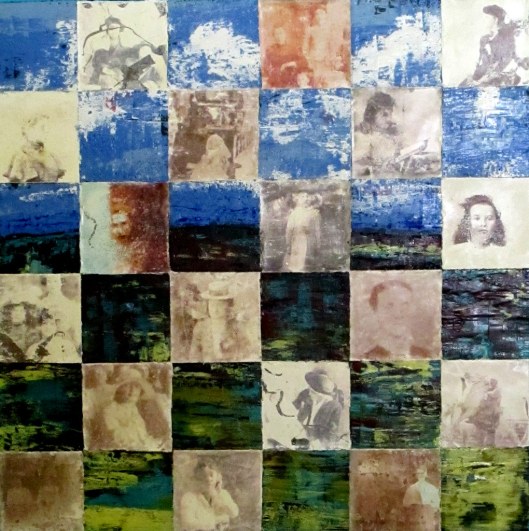 No Homesteads for Women Marlena Wyman Encaustic and photo transfer on birch cradled panel 36″X36″ 2014
No Homesteads for Women Marlena Wyman Encaustic and photo transfer on birch cradled panel 36″X36″ 2014
This painting is in the group exhibit “Women Portraying Women”. The exhibit is part of Art Walk St. Albert taking place on Thursday June 4th. The exhibit continues until June 27, 2015.
VASA Gallery: 25 Sir Winston Churchill Avenue, St. Albert, Alberta Gallery hours: Tuesday to Saturday 10AM to 5PM and Thursday til 8PM.
Background: The 1872 Dominion Lands Act prohibited single and married women from obtaining homesteads. Widows with dependents or women in other unusual situations, such as deserted wives, could file for a homestead but only under very strict qualifying conditions. Georgina Binnie-Clark, a single woman originally from England, came to the Qu’Appelle Valley in Saskatchewan in 1905 to farm, and had to purchase her quarter section of farm land for $2,400, whereas her neighbors, who were men, were able to file for a quarter section homestead for a $10 entry fee. She started the “Homesteads for Women” movement for which she gathered over 11,000 electors’ (men’s) signatures, that she presented to the federal government in 1913, but it was ignored.
She may be the best farmer in Canada, she may buy land, work it, take prizes for seed and stock, but she is denied the right to claim from the government the hundred and sixty acres of land held out as a bait to every man.
…the average hired man seeks wages, and some of them bring more work into the house than they succeed in putting on to the land. The woman who can hitch up her team and go quietly off to the cultivation of her land not only saves her purse the expenditure of the average wage of five shillings a day plus board, but she saves on herself – she conserves her energy.
Quotes from Georgina Binnie-Clark’s book Wheat and Woman, 1914.
Georgina came to the Qu’Appelle Valley area of Saskatchewan from England, in 1905. She farmed for several years as and wrote her book to provide women with information about how to farm in order to prove that this could be a means for single women to gain financial independence. Unfortunately, Canadian homesteading legislation prevented this from being feasible until 1930.
Why hasn’t a Canadian woman a birthright in her own country? In every economic distress that sweeps a land, in every epidemic of disease, in storm or stress of whatever sort, woman bears her full Burden. Full sharer in adversity, why not make her sharer in her country’s gifts?
Quote from Isabelle Beaton Graham’s article Woman’s Sphere in Life and Labour: Homesteads for Women, published in The Grain Growers Guide, November 17, 1909.
The photographs for the image transfers in the painting were selected specifically for their deterioration and obscuring of the subject. Damage includes mold, silvering out, stains, fading, emulsion lifting and cracking. Thanks to the various Alberta archives and staff for helping me to locate these photos in their collections.
Posted by Marlena Wyman

You must be logged in to post a comment.